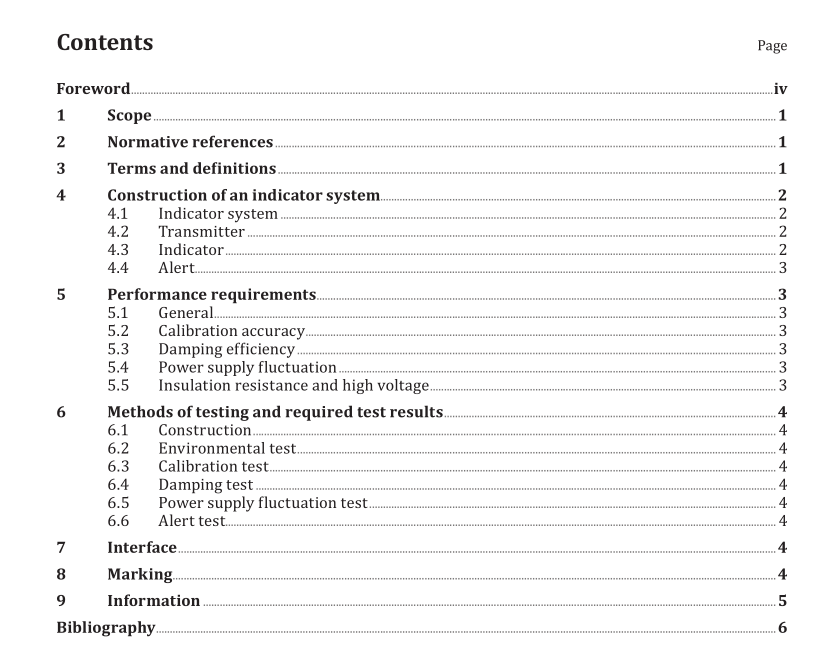ISO 22555 pdf download

ISO 22555 pdf download Ships and marine technology — Propeller pitch indicators
4Construction of an indicator system4.1 Indicator system
a) An indicator system should show information on the state of the equipment or machinery to which it
is connected at locations adjacent to or remote from the equipment or machinery.At the equipmentor machinery, such systems generally comprise a sensor and transmitter; at the observer’s location,such systems generally contain an indicator.
b) In general, the system construction shall comply with the following requirements:
1) the indicator system enclosures shall be robust and constructed so as to facilitate easyadjustment and maintenance;
2) the indicator system shall be provided with an earthing terminal or shall be so constructed as
to be capable of being connected to an electrical earth;
3)
an analogue-type indicator can be used as indicator(s) of the indicator system. It maybe additionally provided by a digital type if fitted. If a display is used for presentation, theequipment shall comply with MSC.191(79), as amended by MSC.466(101), and with IEC 62288.
4.2Transmitter
The transmitter shall be driven by suitable means from the controllable pitch propeller activatingmechanism.
4.3 Indicator
a)An analogue-type indicator shall be of a centre-zero type (preferably circular). Where a circular
scale indicator is used,the zero position shall be uppermost.
The directions ‘ahead’or ‘starboard’shall be to the right of the zero graduation; the directions’astern’ or ‘port’shall be to the left of the zero graduation.
b)A digital-type indicator shall indicate the pitch angle as readily legible digital figures preceded by a
symbol or letter(s) indicating the direction. The directions ahead’ or ‘starboard’ shali be identifiedby the ‘plus’ sign or by the letters ‘AH (ST), while ‘astern’ or ‘port’ shall be identified by a ‘minus’sign or by the letters ‘AS (PT).
c)The maximum angle indicated shall be the same for both ahead/starboard and astern/port and shall be no less than 40°.
d) Scale graduations shall be no smaller than 1°. Graduation marks corresponding to 5°increments shall be more prominent than those for intervening increments.
e)The pointer of an indicator shall be capable of being adjusted to zero.
f) The letters and graduations on the dial shall be such that the direction of ahead and astern can be clearly distinguished.
g) All illumination and lighting of an indicator shall be adjustable down to zero, except the control of the dimmers, which shall remain readable.
h) The illumination and lighting of an indicator shall be arranged in order not to hinder an operator’s vision at night and in order to make the scale, pointer and letters as equally visible as possible, evenin dim light or in the dark.
4.4Alert
lf the equipment is capable of raising an alert, it shall comply with MSC.302(87),IEC 62923-1 andIEC 62923-2.
5Performance requirements5.1 General
The transmitter shall have the capacity to satisfy the requirements specified in 5.2,5.3 and 5.4 when allconnected indicators are operating simultaneously.The manufacturer shall clearly state the maximumnumber of indicator(s) or the capacity of connected indicator(s) that can be supported by a transmitter.5.2Calibration accuracy
To calibrate the indicator system, the shaft of a transmitter is gradually rotated from the zero positionto the maximum angle ahead(starboard) or astern (port), and the angles shown by an indicator arerecorded every 5° of rotation. The difference between the angle of the transmitter shaft and thecorresponding value shown at an indicator shall be within ±1,5 % of the sum of the maximum angle inboth directions.
5.3 Damping efficiency
lf a voltage is suddenly applied while the transmitter shaft is approximately at half of full-scale positionand the indicator pointer is set to the zero position, the pointer shall be reset to that position within 5 sor less.
5.4 Power supply fluctuation
a) The performance specified in 5.1 and 5.2 shall be maintained when the system is subjected to the power supply fluctuations.
b)After repeated makings and breakings, the designated performance shall be demonstrated without carrying out manual adjustments.
)When the rated voltage and frequency are subjected to the combinations of fluctuations, as given in Table 1, the designated performance shall be demonstrated.









